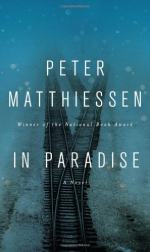
|
| Name: _________________________ | Period: ___________________ |
This test consists of 15 multiple choice questions and 5 short answer questions.
Multiple Choice Questions
1. How old does the narrator say Tadeusz Borowski was in 1948 when his death camp narrative made him famous, in Part III: “Dancing at Auschwitz,” Chapter 13?
(a) 33.
(b) 25.
(c) 35.
(d) 29.
2. What was the name of Clements Olin’s maternal grandmother?
(a) Edith Frankl.
(b) Maria Appelfeld.
(c) Sarah Glock.
(d) Emilie Adam.
3. What is the name of the younger Catholic novice on the retreat?
(a) Sister Ann-Marie.
(b) Sister Catherine.
(c) Sister Maria.
(d) Sister Angela.
4. Who is described as “Becca’s companion, a violinist with long black hair” in Part II: “In the Ogre’s Cave,” Chapter 7?
(a) Jaroslav.
(b) Malan.
(c) Stefan.
(d) Rainer.
5. Adina tells Olin in Part II: “In the Ogre’s Cave,” Chapter 10 that Sister Catherine was suspended from her teaching ministry and her novitiate for questioning the papal ban against what?
(a) The use of birth control.
(b) Admission of guild during the Holocaust.
(c) Gay marriage.
(d) The ordination of female priests.
6. Where is Dr. Stern said to be from in Part II: “In the Ogre’s Cave,” Chapter 6?
(a) France.
(b) Norway.
(c) Sweden.
(d) Greenland.
7. What was Sister Catherine’s name prior to her entrance to novice hood, according to Stefan in Part III: “Dancing at Auschwitz,” Chapter 13?
(a) Michelle.
(b) Elizabeth.
(c) Sarah.
(d) Amalia.
8. For how many years does Malan say he was held prisoner at Auschwitz in Part III: “Dancing at Auschwitz,” Chapter 13?
(a) 7.
(b) 5.
(c) 3.
(d) 4.
9. What is the name of Rainer’s uncle that he says he’s come to Auschwitz to honor in Part II: “In the Ogre’s Cave,” Chapter 7?
(a) Milan.
(b) Stefan.
(c) Werner.
(d) Lublin.
10. Who leads the Christian prayer service that Olin attends with Professor Adina Schreier in the beginning of Part II: “In the Ogre’s Cave,” Chapter 6?
(a) Sister Catherine.
(b) Sister Maria.
(c) Sister Angela.
(d) Sister Ann-Marie.
11. In what year did Josef Mengele join the Nazi Party?
(a) 1931.
(b) 1929.
(c) 1922.
(d) 1937.
12. Where was Pope John Paul II born?
(a) Moscow, Russia.
(b) Cracow, Poland.
(c) Wadowice, Poland.
(d) Berlin, Germany.
13. Who is Erna speaking of when she says to Olin in Part IV: “In Paradise” opens in Chapters 15, “It’s all taken care of, Baron. He’s finished”?
(a) Father Eugene.
(b) Father Mikal.
(c) Stefan.
(d) Franz Xaver Schwarz.
14. How many times does Father Mikal say the novices have attended Confession from him in Part III: “Dancing at Auschwitz,” Chapter 13?
(a) 3.
(b) 2.
(c) 0.
(d) 1.
15. When was Tadeusz Borowski transported from Auschwitz to the Dautmergen subcamp of Natzweiler-Struthof?
(a) 1945.
(b) 1941.
(c) 1944.
(d) 1939.
Short Answer Questions
1. How many female prisoners were held in each barrack of the women’s quarters, according to the narrator in Part II: “In the Ogre’s Cave,” Chapter 8?
2. What Zen master is cited in Part IV: “In Paradise,” Chapter 16 as having written, “All the Universe is one bright pearl. What need is there to understand it?”
3. What word from Part IV: “In Paradise” opens in Chapters 15 refers to a loud electric horn, formerly used on automobiles and now often used as a warning signal?
4. What word from Part III: “Dancing at Auschwitz,” Chapter 12 refers to an ecclesiastic attached to the chapel of a royal court, college, or military unit?
5. The narrator says in Part II: “In the Ogre’s Cave,” Chapter 10 that the “last prisoners in the Cracow ghetto, [Olin] has read, were transported to Auschwitz-Birkenau in August” of what year?
|
This section contains 521 words (approx. 2 pages at 300 words per page) |

|




